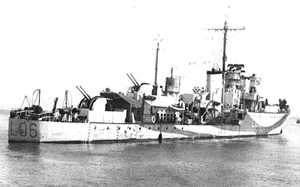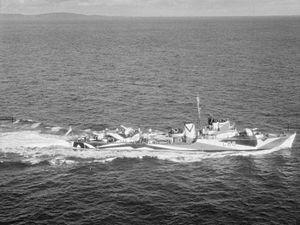
INS Viraat was a Centaur-class aircraft carrier of the Indian Navy. INS Viraat was the flagship of the Indian Navy until INS Vikramaditya was commissioned in 2013. The ship was completed and commissioned in 1959 as the Royal Navy's HMS Hermes, and decommissioned in 1984. It was sold to India in 1987. INS Viraat was commissioned into the Indian Navy on 12 May 1987, and served for almost 30 years.

INS Mysore is a Delhi-class guided-missile destroyer currently in active service with the Indian Navy.

INS Delhi is the lead ship of her class of guided-missile destroyers of the Indian Navy. She was built at the Mazagon Dock Limited in Mumbai and commissioned on 15 November 1997. This class is among the largest warships to be designed and built in India. The Ship was undergoing midlife upgrades from 2018. As of April 2022, she was back in service with Sensor upgrades and new 'Modular Launcher' for Brahmos Missile as a replacement for KH 35E. A Brahmos test was carried out from the ship on 19 April 2022.

The Hunt class was a class of escort destroyer of the Royal Navy. The first vessels were ordered early in 1939, and the class saw extensive service in the Second World War, particularly on the British east coast and Mediterranean convoys. They were named after British fox hunts. The modern Hunt-class GRP hulled mine countermeasure vessels maintain the Hunt names lineage in the Royal Navy.

The Godavari-class frigates were guided-missile frigates of the Indian Navy. The Godavari class was the first significant indigenous warship design and development initiative of the Indian Navy. Its design is a modification of the Nilgiri class with a focus on indigenous content of 72%, a larger hull and updated armaments. The class and the lead ship, INS Godavari were named after the Godavari River. Subsequent ships in the class, INS Ganga and INS Gomati also took their names from Indian rivers.

Mazagon Dock Shipbuilders Limited (MDL), formerly called Mazagon Dock Limited, is a shipyard situated in Mazagaon, Mumbai. It manufactures warships and submarines for the Indian Navy and offshore platforms and associated support vessels for offshore oil drilling. It also builds tankers, cargo bulk carriers, passenger ships and ferries.

HMCS Vancouver, was a Thornycroft S-class destroyer, formerly HMS Toreador built for the Royal Navy in 1917–1919. Seeing limited service with the Royal Navy, the ship was loaned to the Royal Canadian Navy in March 1928. The destroyer served primarily as a training vessel until 1936 when the vessel was discarded.

ORP Ślązak was a World War II Hunt-class destroyer. Initially laid down in 1940 for the Royal Navy as HMS Bedale, in 1942 she was commissioned by the Polish Navy.

The S class was a class of 67 destroyers ordered for the Royal Navy in 1917 under the 11th and 12th Emergency War Programmes. They saw active service in the last months of the First World War and in the Russian and Irish Civil Wars during the early 1920s. Most were relegated to the reserve by the mid-1920s and subsequently scrapped under the terms of the London Naval Treaty. Eleven survivors saw much action during the Second World War.

Admiral Sardarilal Mathradas 'Charles' Nanda, PVSM, AVSM was an Indian Navy admiral who served as the 7th Chief of the Naval Staff from 1 March 1970 until 28 February 1973. He led the Indian Navy during the Indo-Pakistani War of 1971 and successfully executed a naval blockade of both West and East Pakistan, helping India achieve an overwhelming victory during the war. For his important role played in the war, Government of India awarded him with Padma Vibhushan, India's second highest civilian award. He is one of the most notable commanders in the history of the Indian Navy.

HMS Nigeria was a Fiji-class light cruiser of the Royal Navy completed early in World War II and served during that conflict. She was named after the British colony of Nigeria.

HMS Tetcott was a Type II British Hunt-class destroyer built for the Royal Navy during World War II. She was the only Royal Navy ship to be named after the Tetcott fox hunt.
The following ships of the Indian Navy have been named Godavari:
The following ships of the Indian Navy have been named Gomati:

HMS Avon Vale(pennant number L06) was an escort destroyer of the Hunt Type II class. The Royal Navy ordered Avon Vale's construction three days after the outbreak of the Second World War. John Brown Shipbuilding & Engineering Company Ltd laid down her keel at their Clydebank yard on 12 February 1940, as Admiralty Job Number J1569. After a successful Warship Week national savings campaign in February 1942, Avon Vale was adopted by the civil community of Trowbridge, Wiltshire.

HMS Bicester(pennant number L34) was an escort destroyer of the Type II Hunt class. The Royal Navy ordered Bicester's construction three months after the outbreak of the Second World War. Hawthorn Leslie & Co. laid down her keel at their Tyne yard on 29 May 1940, as Admiralty Job Number J4210. The ship was named after a fox hunt in Oxfordshire.

HMS Chiddingfold (L31) was a Type II Hunt-class destroyer of the Royal Navy. She was leased to the Indian Navy in 1952 where she served as INS Ganga (D94).
Vice Admiral Elenjikal Chandy Kuruvila, PVSM, AVSM was a former Flag officer in the Indian Navy. He was the Fleet commander of the Western Fleet during the Indo-Pakistani War of 1971, for which he was awarded the Param Vishisht Seva Medal. He later led the Southern Naval Area and then served as the Chairman and Managing Director of Mazagon Dock Limited.
















